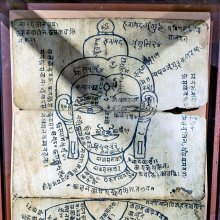Ratti, Rattī: 10 definitions
Introduction:
Ratti means something in Hinduism, Sanskrit, Buddhism, Pali, the history of ancient India, Jainism, Prakrit, Hindi, biology. If you want to know the exact meaning, history, etymology or English translation of this term then check out the descriptions on this page. Add your comment or reference to a book if you want to contribute to this summary article.
Images (photo gallery)
In Hinduism
Ayurveda (science of life)
Nighantu (Synonyms and Characteristics of Drugs and technical terms)
Source: WorldCat: Rāj nighaṇṭuRattī in the Hindi and Marathi language is another another name for Guñjā, a medicinal plants identified with Abrus precatorius (Indian licorice or rosary pea) from the Fabaceae or “legume family” of flowering plants, according to verse 3.113-116 of the 13th-century Raj Nighantu or Rājanighaṇṭu. The third chapter (guḍūcyādi-varga) of this book contains climbers and creepers (vīrudh). Other than the Hindi/Marathi word Rattī, there are more synonyms identified for both varieties of this plant among which twenty-two are in Sanskrit.
Kalpa (Formulas, Drug prescriptions and other Medicinal preparations)
Source: Shodhganga: Edition translation and critical study of yogasarasamgrahaRatti (रत्ति) or Guñjā refers to a unit of measurement of weight (1 ratti equals 125mg; 8 rattis = 1 māṣa = 1g), as defined in the 15th-century Yogasārasaṅgraha (Yogasara-saṅgraha) by Vāsudeva: an unpublished Keralite work representing an Ayurvedic compendium of medicinal recipes. The Yogasārasaṃgraha [mentioning ratti] deals with entire recipes in the route of administration, and thus deals with the knowledge of pharmacy (bhaiṣajya-kalpanā) which is a branch of pharmacology (dravyaguṇa).
A relative overview of weight-units is found below, ratti indicated in bold. In case of liquids, the metric equivalents would be the corresponding litre and milliliters.
1 Ratti or Guñjā = 125mg,
8 Rattis - 1 Māṣa = 1g,
4 Māṣa - 1 Kaḻañc = 4g,
12 Māṣas - 1 Karṣa = 12g,
1 Karṣa /Akṣa - 1 Niṣka = 12g,
2 Karṣas - 1 Śukti = 24g,
2 Śukti - 1 Pala = 48g,
2 Palas - 1 Prasṛti = 96g,
2 Prasṛtis - 1 Kuḍava = 192g,
2 Kuḍava - 1 Mānikā = 384g,
2 Mānikās - 1 Prastha (Seru) = 768g,
4 Prasthas - 1 Āḍhaka (Kaṃsa) = 3.072kg,
4 Āḍhakas or Kalaśas - 1 Droṇa = 12.288kg,
2 Droṇas - 1 Surpa = 24.576kg,
2 Surpas - 1 Droṇī (Vahi) = 49.152kg,
4 Droṇīs - 1 Khari = 196.608kg,
1 Pala = 48g,
100 Palas - 1 Tulā = 4.8kg,
20 Tulās - 1 Bhāra = 96kg.

Āyurveda (आयुर्वेद, ayurveda) is a branch of Indian science dealing with medicine, herbalism, taxology, anatomy, surgery, alchemy and related topics. Traditional practice of Āyurveda in ancient India dates back to at least the first millenium BC. Literature is commonly written in Sanskrit using various poetic metres.
India history and geography
Source: Cologne Digital Sanskrit Dictionaries: Indian Epigraphical GlossaryRattī.—see rati. Note: rattī is defined in the “Indian epigraphical glossary” as it can be found on ancient inscriptions commonly written in Sanskrit, Prakrit or Dravidian languages.

The history of India traces the identification of countries, villages, towns and other regions of India, as well as mythology, zoology, royal dynasties, rulers, tribes, local festivities and traditions and regional languages. Ancient India enjoyed religious freedom and encourages the path of Dharma, a concept common to Buddhism, Hinduism, and Jainism.
Biology (plants and animals)
Source: Wisdom Library: Local Names of Plants and DrugsRatti [रत्ती] in the Hindi language is the name of a plant identified with Abrus precatorius L. from the Fabaceae (pea) family. For the possible medicinal usage of ratti, you can check this page for potential sources and references, although be aware that any some or none of the side-effects may not be mentioned here, wether they be harmful or beneficial to health.
Ratti [ਰੱਤੀ] in the Punjabi language, ibid. previous identification.
Ratti [رتي] in the Urdu language, ibid. previous identification.
Source: Google Books: CRC World Dictionary (Regional names)1) Ratti in India is the name of a plant defined with Abrus precatorius in various botanical sources. This page contains potential references in Ayurveda, modern medicine, and other folk traditions or local practices It has the synonym Abrus cyaneus R. Vig. (among others).
2) Ratti in Tamil is also identified with Ziziphus mauritiana It has the synonym Paliurus mairei H. Lév. (etc.).
Example references for further research on medicinal uses or toxicity (see latin names for full list):
· Notulae Systematicae. Herbier du Museum de Paris (1951)
· Gardeners Dictionary, ed. 8 (1768)
· Kew Bulletin (1970)
· Encyclopédie Méthodique, Botanique (Lamarck) (1789)
· De Fructibus et Seminibus Plantarum (1788)
· Journal of Cytology and Genetics (1984)
If you are looking for specific details regarding Ratti, for example extract dosage, diet and recipes, chemical composition, pregnancy safety, health benefits, side effects, have a look at these references.

This sections includes definitions from the five kingdoms of living things: Animals, Plants, Fungi, Protists and Monera. It will include both the official binomial nomenclature (scientific names usually in Latin) as well as regional spellings and variants.
Languages of India and abroad
Pali-English dictionary
Source: BuddhaSasana: Concise Pali-English Dictionaryratti : (f.) night.
Source: Sutta: The Pali Text Society's Pali-English DictionaryRatti, (f.) (Vedic rātrī & later Sk. rātri.—Idg *lādh as in Gr. lήqw=Lat. lateo to hide; Sk rāhu dark demon; also Gr. *lhtw/ (=Lat. Latona) Goddess of night; Mhg. luoder insidiousness; cp. further Gr. lanqάnw to be hidden, lήqh oblivion (E. lethargy).—The by-form of ratti is ratta2) night D. I, 47 (dosinā). Gen. sg. ratyā (for *rattiyā) Th. 1, 517; Sn. 710 (vivasane=ratti-samatikkame SnA 496); J. VI, 491. Abl. sg. rattiyā in phrases abhikkantāya r. at the waning of night D. II, 220; Vin. I, 26; S. I, 16; M. I, 143; & pabhātāya r. when night grew light, i.e. dawn J. I, 81, 500. Instr. pl. rattīsu Vin. I, 288 (hemantikāsu r.). A Loc. ratyā (for *rātryām) and a Nom. pl. ratyo (for *rātryaḥ) is given by Geiger, P. Gr. § 583.—Very often combined with and opp. to diva in foll. combinations: rattin-diva (cp. BSk. rātrindiva=Gr. nuxqήmeron, AvŚ I. 274, 278; II, 176; Divy 124) a day & a night (something like our “24 hours”), in phrase dasa rattindivā a decade of n. & d. (i.e. a 10—day week) A. V, 85 sq.; adverbially satta-rattin-divaṃ a week DhA. I, 108. As adv. in Acc. sg. : rattin-divaṃ night and day A. III, 57; Sn. 507, 1142; It. 93; J. I, 30; or rattiñ ca divañ ca Nd2 538, or rattiṃ opposed to adv. divā by night-by day M. I, 143; PvA. 43.—Other cases as adv. : Acc. eka rattiṃ one night J. I, 62; Pv. II, 97; PvA. 42; taṃ rattiṃ that night Mhvs 4, 38; imaṃ r. this night M. I, 143; yañ car... . yañ car... . etasmiṃ antare in between yon night and yon night It. 121; rattiṃ at night Miln. 42; rattiṃ rattiṃ night after night Mhvs 30, 16.—Gen. rattiyā ca divasassa ca by n. & by day S. II, 95.—Loc. rattiyañ by night VvA. 130, 315 (aḍḍha° at midnight); PvA. 22; and ratto in phrase divā ca ratto ca Sn. 223; Th. 2, 312; Dh. 296; Vv 315; 8432; S. I, 33.

Pali is the language of the Tipiṭaka, which is the sacred canon of Theravāda Buddhism and contains much of the Buddha’s speech. Closeley related to Sanskrit, both languages are used interchangeably between religions.
Hindi dictionary
Source: DDSA: A practical Hindi-English dictionaryRattī (रत्ती):—(nf) seed of Abrus precatorius; weight approximately equivalent to 2 1/4 grains; —[bhara ummīda na honā] not a dog’s chance; -[bhara paravāha na karanā] not to care a brass farthing.
...
Prakrit-English dictionary
Source: DDSA: Paia-sadda-mahannavo; a comprehensive Prakrit Hindi dictionaryRatti (रत्ति) in the Prakrit language is related to the Sanskrit word: Rātri.
Prakrit is an ancient language closely associated with both Pali and Sanskrit. Jain literature is often composed in this language or sub-dialects, such as the Agamas and their commentaries which are written in Ardhamagadhi and Maharashtri Prakrit. The earliest extant texts can be dated to as early as the 4th century BCE although core portions might be older.
Nepali dictionary
Source: unoes: Nepali-English Dictionary1) Rattī (रत्ती):—n. 1. crab's eye; crab stone; 2. mite; particle; grain;
2) Rattī (रत्ती):—adv. a little;
Nepali is the primary language of the Nepalese people counting almost 20 million native speakers. The country of Nepal is situated in the Himalaya mountain range to the north of India.
See also (Relevant definitions)
Starts with (+11): Ratti safaid, Ratti surkh, Rattibhaga, Rattibhojana, Ratticara, Ratticceti, Ratticheda, Rattidhumayana, Rattihalli, Rattika, Rattikai, Rattikardha, Rattikhaya, Rattikhitta, Rattikkhaya, Rattikku, Rattimcara, Rattimdha, Rattimdiaha, Rattimdiva.
Ends with (+94): Aanayaviratti, Abhivratti, Adavi-pratti, Adavipratti, Addharatti, Anayaviratti, Anayeviratti, Apputtiratti, Aratti, Atcararatti, Avratti, Bharatti, Calantiratti, Campiratti, Capacaratti, Caratti, Cattiratti, Cemmaratti, Cemparatti, Chinapparatti.
Full-text (+82): Rattidhumayana, Gunja, Ratti surkh, Ratti safaid, Dhataka, Gadyanaka, Rattisamaya, Rattai, Vivaseti, Bavana, Ratri, Triyava, Dosina, Krishnalaka, Pala, Addharatti, Ratticara, Atirattim, Rattibhojana, Gunjika.
Relevant text
Search found 14 books and stories containing Ratti, Rattī; (plurals include: Rattis, Rattīs). You can also click to the full overview containing English textual excerpts. Below are direct links for the most relevant articles:
Dhammapada (Illustrated) (by Ven. Weagoda Sarada Maha Thero)
Verse 387 - The Story of Venerable Ānanda < [Chapter 26 - Brāhmaṇa Vagga (The Brāhmaṇa)]
Verse 249-250 - The Story of Tissa < [Chapter 18 - Mala Vagga (Impurities)]
Verse 60 - The Story of a Certain Person < [Chapter 5 - Bāla Vagga (Fools)]
Gemstones of the Good Dhamma (by Ven. S. Dhammika)
Manusmriti with the Commentary of Medhatithi (by Ganganatha Jha)
Verse 8.220 < [Section XXXVII - Breach of Contract]
Verse 11.133 < [Section XV - Expiation for the killing of Cats and other Animals]
Verse 8.134 < [Section XXIII - Measures]
Mahavamsa (by Wilhelm Geiger)
Vinaya Pitaka (3): Khandhaka (by I. B. Horner)
Allowance for three robes < [8. Robes (Cīvara)]
Duties of one deserving rehabilitation < [12. Probation (Parivāsa)]
The Skanda Purana (by G. V. Tagare)
Chapter 80 - The Vrata Called Manorathatṛtīyā < [Section 2 - Uttarārdha]
Chapter 83 - Manifestation of Vīreśvara < [Section 2 - Uttarārdha]
Chapter 79 - Dharmeśākhyāna (Episode of Dharma) < [Section 2 - Uttarārdha]
Related products


